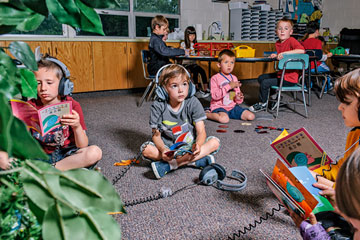
A group of Utah first-graders listen and read along in Mandarin.
(4 of 6)
It's too early to measure exactly what the lifelong benefits of early language training will be, but all of the science suggests that they will be considerable--and that some of the differences will be physically detectable in the brains of the polyglot kids. Research psychologist Ellen Bialystok of Toronto's York University cites brain scans of London cabdrivers, who are celebrated for their down-to-the-last-alley knowledge of their city's streetscape. Those scans show greater development in the regions of the brain responsible for spatial reasoning. Similar findings have turned up in the motor-control regions that govern the fingers of violinists and other musicians. Still, the cause and effect are murky here. "Does the training cause the brain changes," Bialystok asks, "or do you select into being a cabdriver or a musician because you already have a brain that's inclined toward those skills?"
Last year in Sweden, psychologists at Lund University decided to test that idea when it comes to multilingualism, scanning the brains of the incoming class at the Armed Forces Interpreter Academy in Uppsala, where students undergo a grueling program that takes them from no knowledge of an unfamiliar language like Arabic or Dari to total fluency in 13 months. As a control, the investigators scanned other students entering a similarly rigorous program in medicine or cognitive science for the same length of time. At the end of the period, all the students were rescanned. Among the language students, there was detectable growth in the hippocampus, which helps govern memory and mastery of new material, and in three areas of the cerebral cortex, where higher-order reasoning is processed. Among the other students there were no such changes.
Biologist Nina Kraus of Northwestern University has used scalp electrodes to record the activity of the auditory region in the brain stem, looking for how it behaves in bilinguals. What she found is that people who know more than one language are better than monolinguals at picking up speech-relevant sounds, such as key pitches or rhythms, out of a confusing soundscape, producing a telltale blip in the scalp readings. "As people use sound in a meaningful way," Kraus says, "the nervous system changes."
Bialystok believes the relevant difference in the brains of bilinguals involves less the density or shape of the gray matter--the neurons--than the white matter, the myelin sheathing that insulates neural connections. She and her colleagues conducted scans showing healthier myelin in the frontal lobes and the corpus callosum--the neural cable that connects the two hemispheres of the brain--in bilinguals than in monolinguals. "Structural differences are where the new science is unfolding," she says.
Brain Be Nimble
